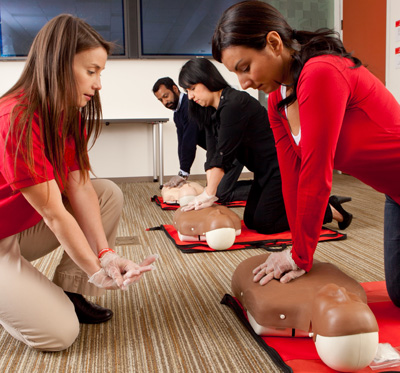
There are a few clear-cut warning signs that indicate when to do CPR on another person:
- Sudden unconsciousness.
- No or limited breathing.
- No pulse.
The surrounding circumstances can also clue you in as to whether CPR is needed. For instance, if the person was electrocuted or drowned; or if they were exposed to drugs or inhaled smoke from a fire. These types of situations can call for CPR.
When do you start CPR?
The answer to that question is almost always “immediately.”
Picture this: you’re walking down the street, and someone in front of you falls over with no warning. Or you’re driving on the highway, and you see an accident by the side of the road. Someone is lying down next to the vehicle—and they aren’t moving.
What do you do? How do you tell when to perform CPR? Here are a few things to consider.
First, call 911 or have someone call for you. Seconds count when it comes to deciding when to give CPR—and all this determination takes time. So before you try to determine what’s happening, call 911 or have someone nearby call for you. That way rescuers will be on their way as soon as possible.
Are they responsive? Try shaking or rousing the person. Are they out cold, or are they responsive but disoriented? CPR is generally called for if the person is unconscious.
Are they breathing? Is their chest rising and falling? Can you hear them breathing if you listen close to their mouth and chest? Can you feel their breath on your skin? If not, they may need CPR.
Do they have a pulse? Sometimes it’s hard to tell if someone has a pulse, especially if you’re a layperson with no medical training. You can check quickly by using your forefinger and middle finger on the person’s wrist—right at the base of their thumb. Don’t use your own thumb—as you have a pulse there that might confuse your reading.
Use your gut. It can take time to look for a pulse in an emergency situation, especially when you’ve never done it before. If the worst occurs, use your best judgment. If you’re having trouble locating the pulse or aren’t sure if the person is breathing, but it’s clear they are out cold, you need to start CPR immediately.
It only takes minutes for irreversible brain damage to occur—and death can happen soon after that. So a fast response is crucial.
When to consider your own safety
Sometimes it isn’t safe to give CPR. We aren’t saying that you shouldn’t stop and help whenever you can—but sometimes, you have to evaluate the scene and use your best judgment. Here are some things to look for.
Beware of criminals. Criminals have been known to lure unsuspecting good Samaritans into stopping by using a “victim” as bait. Women by themselves are a particular target. If you’re by yourself and feel like something may be off about a scenario, listen to your gut and call 911.
Watch out for electrocution. Are there downed power lines nearby? Do you suspect the victim may have been electrocuted? If so, it’s dangerous to approach a victim until the source of the electricity has been turned off. Proceed with caution here.
Assess the scene. Is the victim in a place where it’s unsafe for you to be—in a burning building, in the middle of a busy street, or in a rapidly flooding area? While we encourage bystanders to provide CPR whenever they can, we don’t encourage you to put your own life in danger.
Even if you can’t deliver lifesaving CPR, it’s essential to call 911 so rescuers can get to the victim. Calling 911 quickly may still save the person’s life.
When to stop giving CPR
Once you start CPR, don’t stop unless one of these things happens:
- The victim becomes responsive or starts breathing.
- Another trained rescuer or EMS personnel arrive and take over.
- An AED becomes available.
- You are too exhausted to continue.
- The area becomes unsafe.
Under older guidelines, rescuers would generally stop CPR after 30 minutes—as it was believed if the victim hadn’t resuscitated by then, they wouldn’t.
However, the American Heart Association now states that giving CPR for as long as 38 minutes can have a major effect on the patient’s chances of recovery. They also say that keeping CPR going that long can improve brain function in survivors of cardiac arrest.
Some people have even recovered after three or more hours of CPR—including this 29-year-old man https://www.sca-aware.org/sca-news/three-and-a-half-hours-of-cpr-bring-29-year-old-back-to-life. These days, there is no proscribed time to stop CPR unless one of the above situations occurs.
Where are people most likely to need CPR?
The answer to that is “anywhere.”
Cardiac arrest can occur without warning, in people who have no prior heart problems or symptoms. And the majority of cardiac arrests occur outside of the hospital—which means bystanders are a victim’s first and best chance of getting lifesaving CPR immediately.
Approximately 10,000 cardiac arrests happen in the workplace every year, and over 395,000 occur outside of a hospital. That’s compared with about 200,000 cardiac arrests that occur in a hospital setting.
This means that if you’re called upon to deliver CPR—unless you’re a healthcare professional—the most likely place you’ll be is on your own, going about your day in a place where emergency services aren’t immediately available. The victim could be a family member, coworker, or stranger.
Not everyone has the confidence to react quickly and deliver emergency care in an unexpected situation. Taking CPR training and getting certified can help you prepare to take charge while you wait for emergency responders to arrive—and it’s worth doing.
It only takes five minutes or so to learn the simplest form of CPR, and knowing how to do it could help you save a life—possibly the life of someone you know.